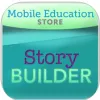Take a look inside 5 images
StoryBuilder
Pros: Well-crafted, progressive levels adapt storytelling to fit each student's needs.
Cons: The story-starter images lack diversity and depict only traditional gender roles.
Bottom Line: StoryBuilder uses a fun and creative activity to support the development of critical-thinking and language skills.
StoryBuilder can teach students about the basic steps for good storytelling as well as how to reply to questions in narrative form. Since the app doesn't provide feedback, practice may be most effective one-on-one with teachers tracking progress, at least until a student gets the gist of the exercise. You may want to share stories on StoryBuilder via email with a student's speech therapist and parents to demonstrate specific issues or evaluate and note progress.
StoryBuilder is a language-arts app for kids who need to improve their sentence formation, storytelling, and speaking. It's extremely well-designed and suitable for general learning as well as for special needs classrooms. Do your students have trouble answering questions in complete sentences? Is it difficult for them to integrate progressive ideas into a narrative? StoryBuilder may be just the tool that can help them develop those skills, as students record their own answers to questions about pictures that tell a story.
There are three levels of play on StoryBuilder. Each requires kids to look at pictures and make inferences based on questions (or, on the last level, solely from their imaginations) to form a story. The first level includes four questions directly related to one picture shown throughout each of four question screens. Kids record their answers verbally by tapping the Record tab on each page. These answers create a story that kids can play back, and they can hear their own voices telling the story. The second level also includes an image and questions, but ones that require more complex thought. The third level has no questions; it's the place for free-flow storytelling. There's also a Story Introduction Reinforcement tab that provides the first few words of a potential answer so kids learn to respond in complete sentences. For example, "Where is the cat?" prompts kids to answer, "The cat is on the porch," rather than just "on the porch."
Kids can have a lot of fun with creative storytelling as they build analytical, speaking, and language skills. Many settings adapt play, including color-coded prompts. Kids can save stories they record and also share them via email. Multiple users can create profiles and save stories, but only one can be logged in at a time. The app's repetition of audio and visual cues gives extra support for kids who struggle with auditory and language processing.
The images on StoryBuilder tend to be funny, dramatic, or active in ways that make for engaging stories. That said, there's almost no diversity, and the characters in the stories tend to adhere strictly to gender stereotypes. It would be nice to see stories with more diversity and a broader scope of experiences for the characters.











